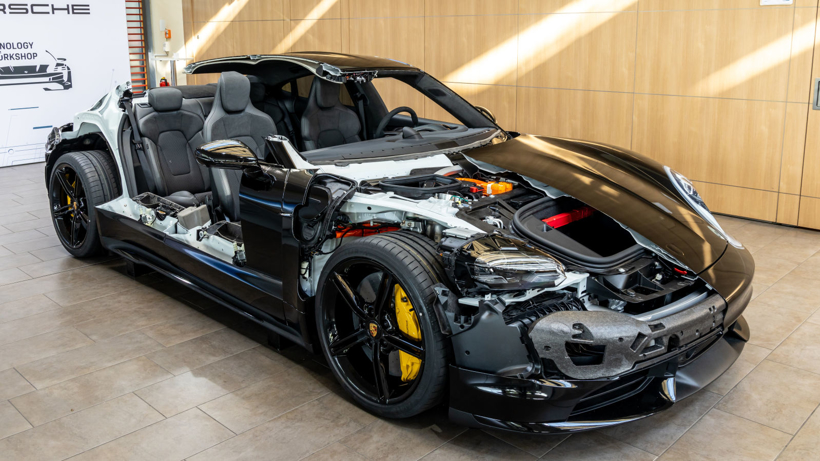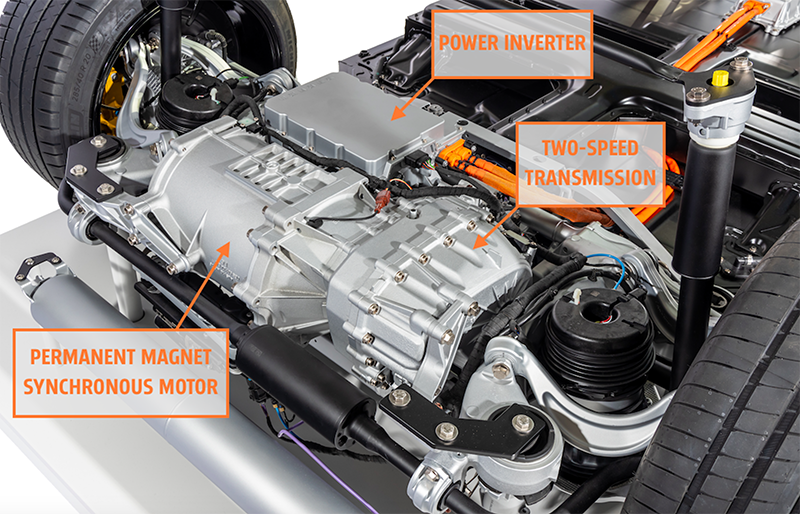Last month, Porsche officially released the first pure electric sports car, the Taycan, with earlier versions of the Turbo and Turbo S, even if there is no turbo on the car.
In order to achieve both acceleration and high-speed performance, Porsche uses two high-performance permanent magnet synchronous motors, one for each front and rear axle. Normally, it can output a maximum of 617 horsepower (460kW) for 10 seconds. In addition, there is an Overboost of 2.5 seconds to start the ejection. At this time, the Turbo S version can output up to 751 horsepower (560kW) and 1050Nm power. 850Nm, the official 100 km acceleration time is the fastest 2.8 seconds, to 200km / h only takes 9.8 seconds, top speed of 260km / h.
Performance is scary, but even more revolutionary is that, as an electric vehicle, Taycan is equipped with a two-speed gearbox for the first time. Compared with traditional engines, electric motors have a wider output range, can output almost all torque at very low speeds, and can guarantee good power efficiency in most speed ranges. Therefore, most electric vehicles use a single-speed transmission to transmit power, and there is no need to use a multi-speed transmission on a conventional diesel locomotive.
However, this does not mean that single-speed transmissions can already meet the current and future electric vehicles. For example, from the perspective of pursuing extreme performance, Porsche is not satisfied.
The two-speed gearbox is actually a bold idea
Since a two-speed transmission is needed, it is naturally hoped that both the torque and the acceleration capability can be increased, as well as the maximum speed. But first, the Taycan is not equipped with a two-speed gearbox, but a two-speed gearbox on the rear axle. There is still a traditional single-speed gearbox on the front axle. But the two-speed gearbox that Porsche built for the Taycan really cost a lot of money.

As a Porsche, in order to ensure performance, Taycan uses two permanent magnet motors. However, because the permanent magnet motor affects energy consumption and battery life in daily driving, and the "fast" of Porsche must be both accelerated and extremely fast, the idea of a two-speed transmission was born. At the same time, permanent magnet synchronous motors need better heat dissipation capabilities. In order to ensure the continuous performance of the vehicle and the maximum discharge rate, Porsche has also designed a very complex cooling system with high cooling power. Water cooling system for heat exchange between the three circuits and the air-conditioning pipeline. But it also increases energy consumption.
Therefore, in order to save energy consumption and avoid the drag effect caused by the idling of the permanent magnet motor, the rear axle can be completely disconnected on the basis of the two-speed gearbox. The structure of the transmission is a bit more complicated, and it is not easy for Porsche to finally make such a transmission.
Although it has only two speeds, it has also entered the ranks of multi-speed gearboxes. Compared with single-speed gearboxes, it has already achieved a qualitative change. Since it is multi-gear, it also has a series of advantages of the transmission on a traditional fuel car, such as improving low-speed acceleration capabilities and improving driving efficiency by reducing engine speed under high-speed conditions. A wider range of gear ratios can help Taycan have more high-speed cruising range, while also improving acceleration capabilities.
Complex structure but good results
This gearbox independently developed by Porsche weighs about 70kg and can withstand a maximum torque of 550Nm. With a planetary gear set and two clutches, one clutch is responsible for completing the normal shifting action, while the second can separate the rear axle motor from the entire rear axle. There is only one shift actuator in the entire transmission, and it is responsible for the execution of all gears in the first gear, second gear, reverse gear, neutral gear, and P gear by controlling the opening and closing of the two clutches. In other words, if power saving is needed, the Taycan can be driven by the front axle only, and it becomes a more economical front-wheel drive vehicle.
The gear ratio of the two gears of the gearbox cannot naturally be as close as that of the traditional gearbox. The gear ratios of the two gears are approximately 16: 1 and 8.05: 1, respectively. The gear ratio of the second gear is almost half that of the first gear. The point will be at a speed of about 90km / h. Most of the time, the Taycan will drive in second gear, which will greatly increase the economy of the vehicle at high speeds. When the vehicle is in Sport or Sport Plus mode, it will use the first gear directly. If it is in normal mode, you can press your pedal deep enough.
The following figure shows the timing of Taycan gearbox shifting. The upper picture is the Range mode, which can be understood as the mode that more favors the endurance orientation. The lower picture is the Sport mode. The purple and blue lines represent the first gear. And second gear shift timing. So from the figure we can also see that the Range mode starts and defaults to the second gear most of the time. Only at the low speed of about 40km / h and with a very high speed is the purple line where the vehicle will cut. Go back one gear, as we said above. After the speed is up, no matter how the throttle is given, the vehicle will rise to the second gear at about 70-75km / h.
In fact, Porsche also wants to make some articles on the gearbox of the front axle, such as adding clutch discs for decoupling, but the whole car is too complicated. So from the perspective of production maintenance and cost, the electric drive unit of the Taycan front axle is now connected in real time. Fortunately, the relatively low power motor and planetary gearbox transmission of the front axle will not consume too much energy, and it means that this Taycan It cannot be turned into a pure rear-drive model.
We can also see the difference between a two-speed gearbox and a single-speed gearbox through the illustration of torque output and speed on wheels. Among them, the green line is the rear axle output, the dark green is the first gear, the light green is the second gear, the red line is the front axle output, and the blue is the comprehensive output first. In the shifting area of the gray vertical bar, we can see that the torque output of the first gear gradually decreases and intersects with the curve of the second gear, and is then overtaken by the second gear (the first gear becomes a solid line and the second gear becomes a solid line), and The gear curve finally stopped because it had reached its maximum output at 16,000 rpm, which was naturally not conducive to re-acceleration. Later, the torque output after the gear shift continued to accelerate the vehicle.
At the same time, on the output shaft of the gearbox, Taycan is also equipped with a multi-plate clutch-type electronic limited slip differential, which is the same as many other Porsche products. We have seen a lot of vehicles with dual motor settings on the rear axle, which independently control the two rear wheels, respectively, and have a more rapid torque distribution than the differential. However, it is clear that Porsche has chosen a conservative approach, using a combination of single motor and differential. It may also be due to packaging and cost, after all, it is already so expensive.
Thanks to the rear two-speed transmission, permanent magnet synchronous motor, and high-voltage 800V voltage platform, the Taycan Turbo S has the highest power specification of 751 horsepower. It has previously performed 26 consecutive 0-200km / h acceleration tests without Significant performance degradation. According to Porsche, even if the battery is already below 50%, the performance of the vehicle will not have any impact.

The entire rear-drive unit is designed to be as compact as possible to ensure space in the trunk. When rear-end collisions or rear accidents occur, the motor and transmission structure at the rear of the vehicle are designed to collapse upwards and forwards to maximize the safety of the battery pack.
As we all know, Tesla tried the two-speed gearbox on its Roadster at the earliest. However, due to various problems, the plan of the speed-speed gearbox was stranded and the single-speed gearbox was still used. In earlier versions, Courtesy of BorgWarner. But Tesla and BorgWarner's failure to build does not mean that Porsche can't. really.
Coincidentally, ZF also released its own two-speed transmission
As one of the world's most mainstream transmission suppliers, ZF has just released a new two-speed transmission for electric vehicles, which can effectively improve the operating efficiency of electric vehicles without taking up too much space in the car. ZF's gearbox unit also integrates a motor and a reducer, but the reducer has two gear ratios. Structurally, it is more compact than the two-speed transmission of the Porsche Taycan, but the ZF is equipped with more comprehensive shift logic.
The default setting of this transmission is to shift at a speed of about 69km / h, but this point is not fixed. The system will adjust the shift timing according to the vehicle operating conditions and even based on the map and terrain information. When the system thinks that the cruising range to the next charging point starts to be tight or insufficient, it can also actively adjust the gear to reduce the range pressure. The entire transmission program can also be updated via an OTA upgrade.
After one more gear, ZF said that it can make the car more efficient, and can increase the cruising range by 5% compared to the traditional single-speed gearbox structure. Host manufacturers can also be equipped with smaller batteries to reduce vehicle weight. Not only in terms of efficiency, ZF can increase the extreme speed of electric vehicles through one more gear, solving the disadvantages caused by many electric vehicles at the highest speed in order to ensure low-speed acceleration performance.
Earlier, it was rumored that the ZF's two-speed gearbox would be used in the Porsche Taycan, but apparently, Porsche kept it alone.
In addition, on ZF Global Technology Day, they also showed a new generation of 8-speed hybrid automatic transmissions. The maximum power of the motor is 160kW and the continuous output power is 80kW. Without starting the engine, the maximum torque can reach 450Nm, and high-speed driving can be achieved even in the pure electric mode. This is another move for ZF towards new energy.

